Dark Matter
Why in News?
Physicists have revised the minimum possible mass of a dark matter particle.
- Dark matter – It is an enigmatic invisible substance supplying five-sixths of the matter of the universe.
- It is said to be everywhere in the universe.
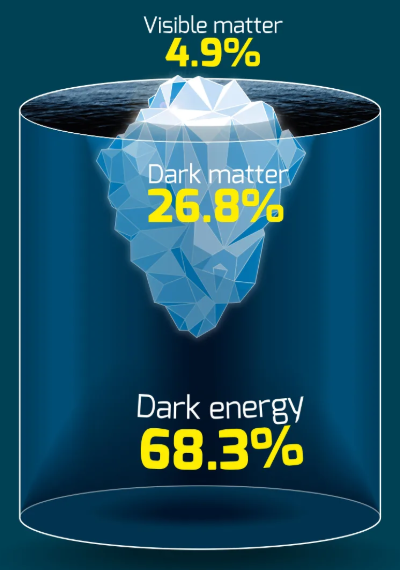
- Coverage – It seems to outweigh visible matter roughly 6 to 1, making up about 27% of the universe.
- Properties – Unlike normal matter, dark matter does not interact with the electromagnetic radiation (heat, light, radio, etc,).
- Hard to spot - It does not absorb, reflect or emit light.
- Exploration – The existence of dark matter was inferred only from the gravitational effect it seems to have on visible matter.
- The evidence for dark matter emerged in the 1970s when astronomers found an unusual pattern in the rate at which stars in a galaxy rotated the farther they were from the centre.
- Non-Zero mass – The particles of dark matter need to have non-zero mass or else the dense and intricate structure of matter on cosmic scales will not form.
In 1922, Dutch astronomer Jacobus Kapteyn studied the motion of stars neighbouring the Sun and concluded the density of “dark matter” (using that term for one of the first times) must be 0.0003 solar masses per cubic light year.
- Minimum mass – For decades scientists thought this minimum mass was about 10-31 times the mass of a proton.
- In 2024, theoretical physicists revised the limit and pushed it up by an order of magnitude, to 2.3 × 10-30 proton masses.
- In this case, the wavelength is 200 light years, about the size of a dwarf galaxy.
Leo II is a dwarf galaxy orbiting the Milky Way.
- R&D - Experiments at the Large Hadron Collider (LHC) may provide more direct clues about dark matter.
- Dark matter might be newer particles like
- WIMPS (Weakly Interacting Massive Particle)
- AXIONS
- Gravitinos
Reference
- The Hindu| Revision of minimum mass of Dark Matter
- CERN| Dark Matter
Young Lawmakers
Why in News?
The youth representation in the Indian Parliament was critically low from 1951–52 to 2024 according to data from the Association for Democratic Reforms.
- Young Lawmakers – It refers to the representation of young adults in the age group of 25-40 years in legislatures.
- Trends in Lok Sabha – Members of Parliament (MPs) and Members of Legislative Assemblies (MLAs) are typically middle aged and form a majority in most political parties.
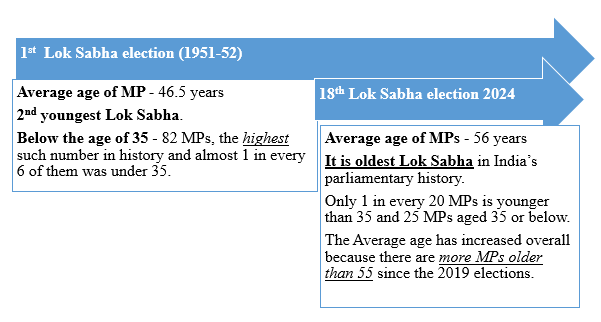
- Young MPs – Most political parties’ MPs are aged 46 to 65.
- Congress has largest share of young MPs.
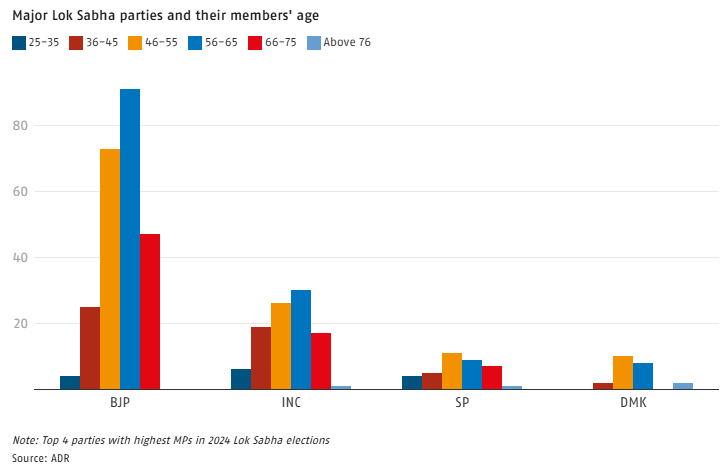
The Lok Sabha elected in 1998 was the youngest where the average age of its MPs was 46.4 years.
- Young MLAs – The young are underrepresented in state assemblies as well.
- After elections in 8 states in 2024, the share of MLAs aged 40 or younger is 10% or less.
- Arunachal Pradesh – No MLA aged 40 or younger.
- Jharkhand – 16% of its MLAs are under the age of 40.
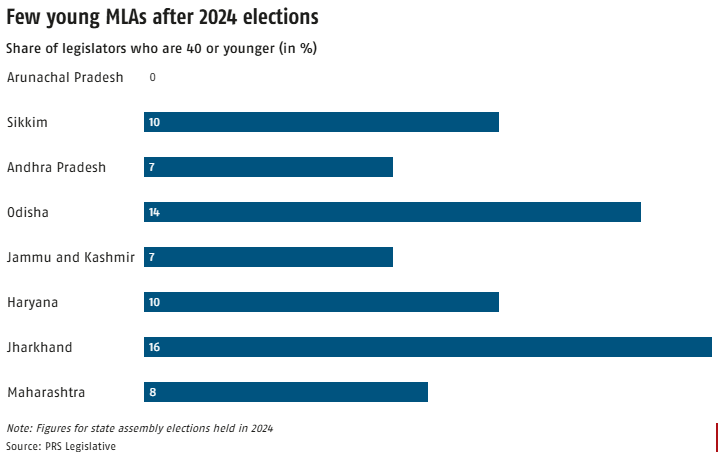
Jharkhand is the youngest state assembly among the newly elected governments in 2024.
Reference
Business Standard| Young Lawmakers in India
Quasar
Why in News?
Recently, the astronomers have identified a remarkable water reservoir circling a quasar over 12 billion light-years away.
- Quasar – It is a subclass of Active Galactic Nuclei (AGNs), extremely luminous galactic cores where gas and dust falling into a supermassive black hole.
- Formation – It occur when immense amounts of matter fall into a supermassive black hole, spiraling around it in the form of a disk before entering.
- Luminous object – The accretion disk is subjected to extreme gravitational and frictional forces, causing the gas and dust to heat up to millions of degrees.
- Thus, it become luminous, blasting out dazzling jets of material into the universe.
- Together, the jets and glowing disk outshine their host galaxies.
- Features – Though they aren’t much bigger than Earth's solar system, they emit 100 to 1,000 times as much light as an entire galaxy.
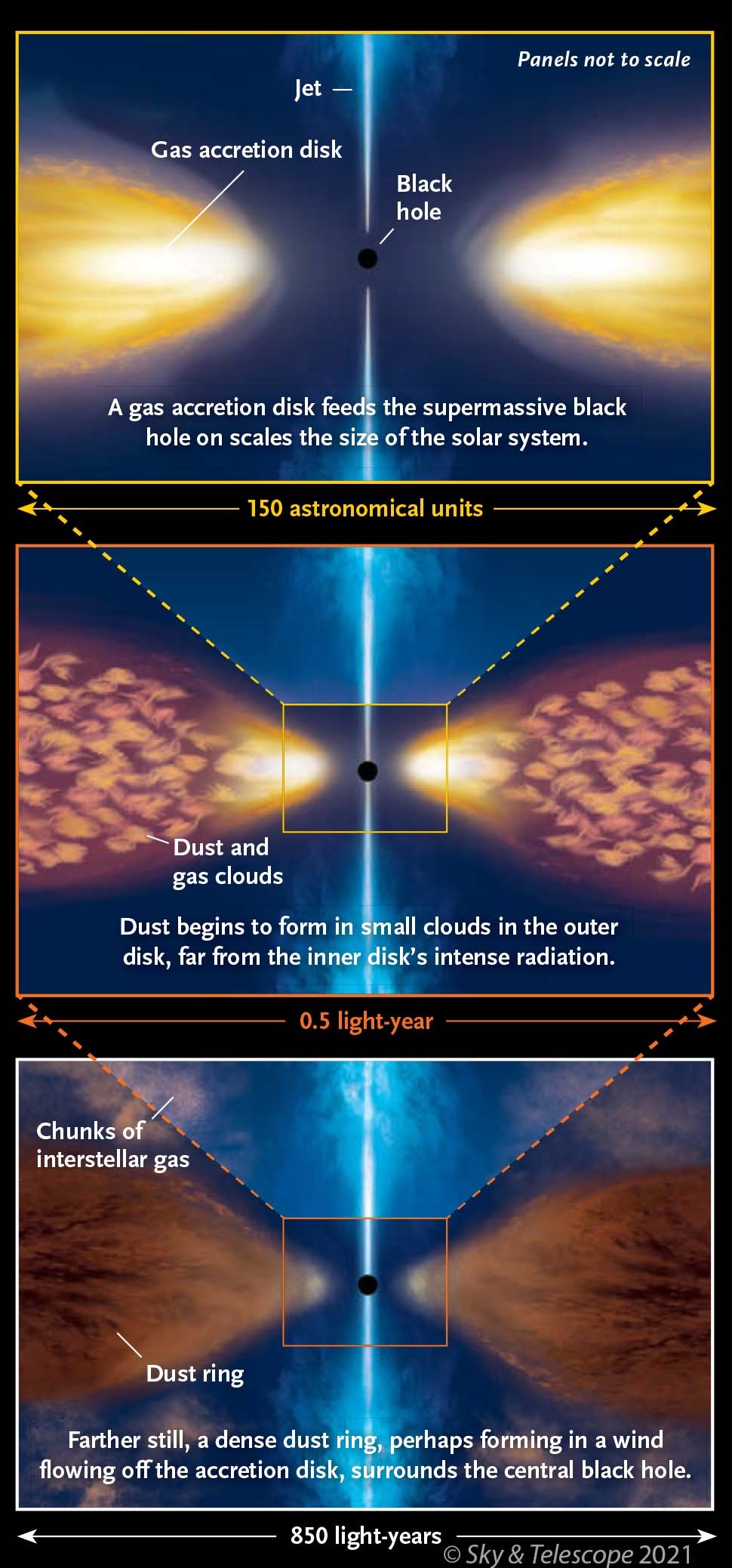
- Discovery – They were 1st found in the 1950s and 60s and labeled “quasi-stellar radio sources,” because they looked like stars but emitted radio waves.
- The closest quasars to Earth are 100s of millions of light-years away.
Hubble telescope found quasars in both spiral and elliptical galaxies, colliding and undisturbed, which may indicate a subtler mechanism for feeding a supermassive black hole than galaxy collision.
Quasar APM 08279 5255
- Size - It surrounds a supermassive black hole that is 20 billion times more massive than our Sun.
- Energy – It pumps out as much energy as a 1000 trillion suns.
- Water reservoir – It contains water vapour equating to 140 trillion times the volume of Earth’s oceans.
- It is the farthest and largest known reservoir of water source in the universe.
- Features – It is emitting hydrogen-rich gases like water vapour and carbon monoxide, and creating a region 100s of light-years wide.
- The gas is warm and dense compared to typical galactic conditions.
- The intense radiation from the quasar keeps the surrounding gas active.
- It primed for star formation or feeding the black hole, potentially increasing its mass 6 fold.
References
- Telangana Today| Water Reservoir Surround a Quasar
- ESA| Quasar
Centres of Excellence for Rare Disease
Why in news?
The Union Ministry of Health and Family Welfare is discussing adding more Centres of Excellence (CoEs) to its network of centres to improve access to diagnosis and treatment for patients suffering from rare diseases.
- Centres of Excellence – They are institutions identified by the central government under the National Policy for Rare Diseases (NPRD), 2021.
- Aim – To treat patients suffering from rare diseases actively.
|
Rare disease
|
- Definition – According to WHO, Rare disease is a lifelong disease with a prevalence of 10 or fewer per 10,000 population.
- According to Organization of Rare Diseases India (ORDI) defined rare disease as a disease when it affects 1 in 5,000 people.
- Spread – It affect approximately 3.5% to 5.9% of the population.
- Causes – 72% of rare diseases are genetic, with over 7000 characterized by diverse disorders and symptoms.
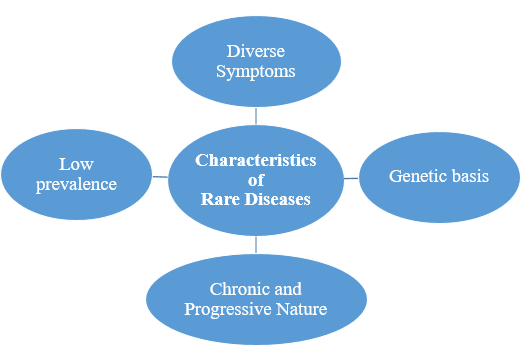
|
- Numbers – There are 12 such centres.
- Coverage – These centres cover with a quota of 2,420 rare disease patients from 6 categories across 3 groups.
|
Categories of Rare Disease - NPRD
|
- National Policy for Rare Diseases (NPRD) – It was launched by Ministry of Health & Family Welfare launched in 2021.
- There are 3 groups based on the type of treatment they require.
- Group 1 – Diseases that can be cured with a one-time treatment.
- Group 2 – Diseases that require long-term or lifelong treatment, but are relatively inexpensive.
- Group 3 – Diseases that have a definitive treatment, but are expensive and require lifelong therapy.
|
Currently, 63 rare diseases are included under NPRD on recommendation of Central Technical Committee for Rare Diseases (CTCRD).
- Tax exemption – GST and Basic Customs Duty on drugs imported for Rare Diseases for individual use and through CoE.
- Challenges – It has lack of institutional care at CoEs to the exhaustion of the one-time fund of Rs 50 lakh given to patients.
- It fails to support sustained treatment for chronic conditions like Lysosomal storage disorders (LSDs).
|
Most common rare disease in India
|
- Lysosomal Storage Disorders
- Pompe disease (Glycogen storage disease type II)
- Anderson–Fabry disease
- Mucopolysaccharidosis
- Severe Combined Immunodeficiency (SCID)
- Phenylketonuria
- Cystic Fibrosis
- Duchenne Muscular Dystrophy
|
Rare Disease Day was observed on the last day of February i.e., 28th February (or 29 in leap years).
Reference
PIB | National Policy for Rare Diseases
|
One Liners 24-12-2024
|
|
Geography
|
|
Caucasus Mountains
- They are a mountain range that stretches between the Black Sea and the Caspian Sea, connecting Europe and Asia.
- Division - Greater Caucasus and Lesser Caucasus
- Border nations - Armenia, Azerbaijan, Georgia, Russia, and Turkey
- Highest peak - Mount Elbrus
|
|
Economy
|
|
National Consumer Day - 24th December
- 2024 Theme - Virtual Hearings & Digital Access to Consumer Justice
Jago Grahak Jago App
- Usage - It provides essential e-commerce information about all URLs during a consumer’s online activities.
- It alerts consumers if any URL may be unsafe and requires caution.
Jagriti App
- Usage - It allows users to report URLs where they suspect the presence of one or more dark patterns declared illegal.
|
|
Environment
|
|
Transformative Change Report
- Published by – Intergovernmental Science-Policy Platform on Biodiversity and Ecosystem Services (IPBES).
- Focus – It focuses at underlying causes of biodiversity loss, determinants of transformative change and options for achieving the 2050 Vision for Biodiversity.
Bordoibam-Bilmukh Bird Sanctuary
- Location – It is situated in north-eastern Assam.
- It is declared as a wildlife sanctuary in 1996.
- The number of avian species declined by almost 72% in 27 years.
Protected Area Permits/Restricted Area Permit (RAP)
- Protected Area – Under the Foreigners (Protected Areas) Order, 1958, it includes all areas falling between the ‘Inner line' and the International Border of the State.
- Permit - Every foreigner, except a citizen of Bhutan, who desires to enter and stay in a Protected or Restricted Area, is required to obtain a special permit from a competent authority.
- Areas covered by PAP - Whole of Arunachal Pradesh, Whole of Manipur, Whole of Mizoram, Whole of Nagaland, Whole of Sikkim (partly in Protected Area and partly in Restricted Area), Parts of Uttarakhand, Parts of Himachal Pradesh, Parts of Jammu & Kashmir and Parts of Rajasthan.
|
|
Science
|
|
Branched-chain amino acids (BCAAs)
- BCAA – They are essential nutrients including leucine, isoleucine, and valine.
- They are found in meat, dairy, and legumes.
- Building of protein - BCAAs stimulate the building of protein in muscle and possibly reduce muscle breakdown.
|
|
Miscellaneous
|
|
Society for Materials Chemistry Medal-2024
- Awarded to Sandhya Shenoy – For her research mainly involves materials for energy and environmental applications focusing on thermoelectric and photocatalytic properties.
- Society for Materials Chemistry - SMC is a professional scientific body founded in 2007 to promote education, research, and applications of materials chemistry among scientists and engineers in India and abroad.
Near East and North Africa Regional Overview of Food Security and Nutrition Report
- Launched by - FAO, the International Fund for Agriculture Development (IFAD), UNICEF, the World Food Programme (WFP), WHO and the United Nations Economic and Social Commission for Western Asia (ESCWA).
- Coverage - covers 22 Arab states spread across West Asia, North and East Africa.
- Arab region – It continues to struggle with a triple burden of malnutrition — undernutrition, micronutrient deficiencies (anemia among women) and obesity.
|




